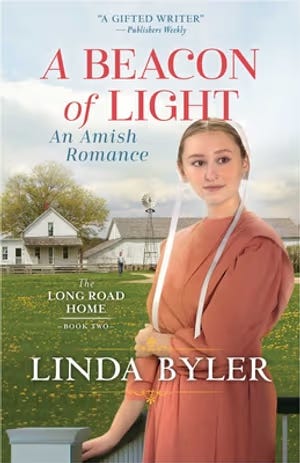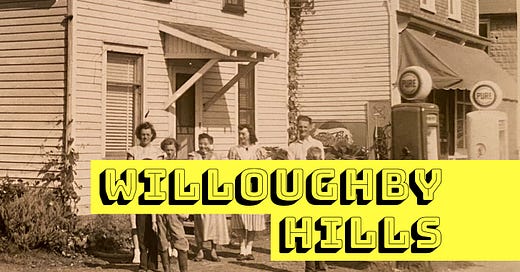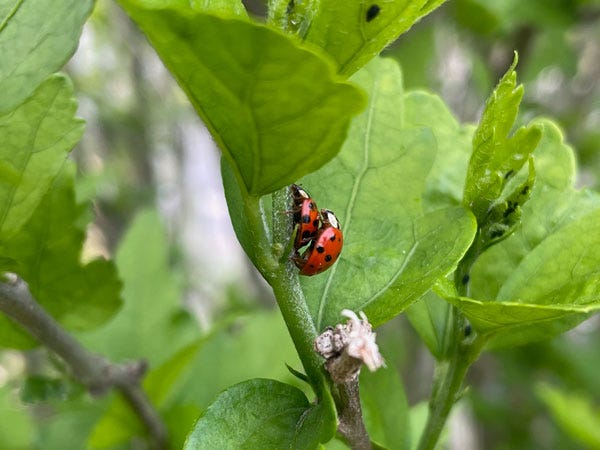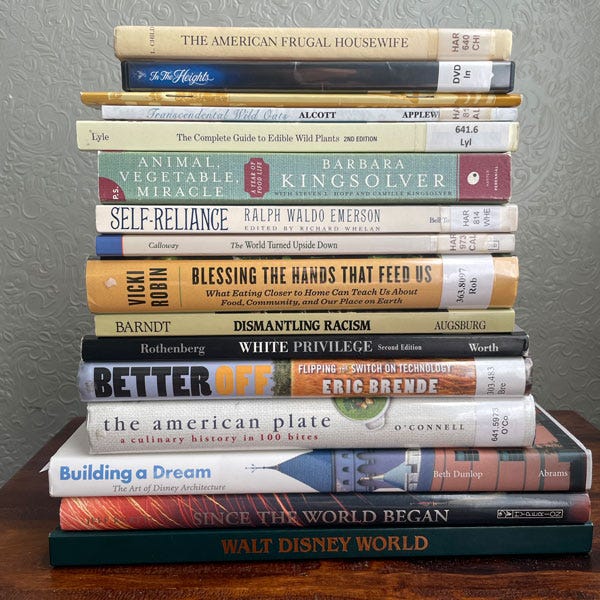Wednesday Walk: Pondering the General Store
Insect reproduction, a pile of books from a single category, and keeping general stores alive
Welcome to Willoughby Hills!
If you enjoy what you’re reading, please consider a free subscribtion to receive emails every Wednesday and Sunday plus podcast episodes every two weeks. There are also paid options, which unlock even more features.
As is typical every Wednesday, I’m bring you a smattering of topics that I hope will make you a bit more curious about the world around you and give you something to think about later. I call these Wednesday Walks, as it’s the type of conversation we might have walking down a path in the woods. Shall we take a stroll?
Ladybug Boogie
I’ve been working on cleaning up our garden recently and came upon a rather, um, private scene on our rose of Sharon.
I’m not going to lie- I took this photo to indulge my inner 13 year old. It was much less about being a scientist or conservationist than it was simply being Beavis and Butthead. Call me immature, but catching creatures in the act can be a little funny.
However, the next day, I was looking at the same plant and noticed something pretty rad.
Those little yellow specs are actually ladybug eggs! My immature giggles turned to awestruck wonder. I was witnessing the circle of life right here in my front yard.
Do you know why those ladybugs decided to drop some eggs on my rose of Sharon? Because the plant tends to attract aphids during the spring, an insect which eats the foliage. The ladybugs are natural predators of aphids and lay their eggs near aphids so that their young can consume them.
I only know this because I’ve been through it before some years ago. In fact, I took photos then too and turned them into a “viewer” question on a segment of Ask This Old House I produced. “Seema from Massachusetts” happens to be my wife.
If you’re curious, you can watch the full segment here (it’s less than 2:00):
The Rural General Store
There’s a new episode of the podcast this week featuring HGTV’s Ben Napier which will go live tomorrow (a reminder that paying members get early access to the podcast and can listen right now, so if that’s of interest, upgrade today).
Ben and I spoke a lot about what it takes to build a perfect small town, a subject that he is well versed in as the proprietor of three businesses in his home town of Laurel, Mississippi. One of these is Scotsman General Store, which aims to recreate a classic general store experience.
I recently came across a report on CBS Sunday Morning about the people (not unlike Ben and Erin) who are trying to save rural general stores.
The report by Conor Knighton cites the example of The Genny in Albany, Vermont, a general store which caught fire a few years ago and was beyond salvaging. The new store is owned by the community and operated by a private group, the only possible arrangement which would have allowed the store to continue to exist.
Ben discusses this challenge in tomorrow’s episode as well. A general store is often the life blood of a community, but they are also barely profitable. They are a vital service that often need to be seen as a labor of love in order to succeed, which makes them very unsustainable.
The report on CBS got me thinking about the blurred line between government and commerce. As much as we like to think our economy is free market capitalism, in truth, the government puts its finger on the proverbial scale for all kinds of businesses from fossil fuels to big agriculture to film production. I like the model that Knighton showed where government funds can be used to benefit community businesses as well.
The report also reminded me of my own great-grandparents, who I mentioned a few weeks ago used to run a small country store. Just last night, my mom happened to dig out a very cool photo of their old store which she sent to me. I had never seen it before.

Apparently, they lived in the house in the foreground, and the store is the building next door. I have no idea what else would have been around this block, but I love seeing a rural example of a mixed use block like this, even if it’s only two buildings wide. The house and store look nearly identical in size and construction, but the false facade and awning on the storefront send the message that it’s a commercial building. Modern zoning would not allow anything in this picture to exist as it does here, yet it’s a functional and smart way to live.
I also love that this little rural store was also the gas station in town (and strangely, the gas pumps seem to be in front of the house, not the store). I’ve written before about my fascination with extreme gas stations like Buc-ee’s, and this is at the complete other end of the spectrum from that.
The general store is a relic from another time, although I hope we’re starting to realize that there is some value in having a locally owned and nearby place to pick up a few necessities, visit with neighbors, and know the shopkeeper by name. The pendulum has been swinging towards big box stores and chains for two or three generations, and I hope it’s on its way back to something a little smaller.
Nothing But the Truth
As I wrote about on Sunday, I have recently started seeking out CDs and rebuilding my collection of physical media.
When it comes to books, I have tried to be more choosy about what I bring home. We already have several bookshelves full of them, and when you live in a house occupied by four people in under 2,000 square feet, storing excess books can feel especially foolhardy.
Perhaps someday I’ll have a giant library like the beast (known as “Beast”) from Beauty and the Beast. But for now, I have to settle with cramming books on my random homemade book cases scattered throughout the house. (Apropos of nothing, listen back to my interview with animator Glen Keane, who shared the story with me of how he designed the look of Beast).
Much like digital music, my solution for a long time with books was to purchase them on Amazon to read through my Kindle. I could store hundreds of books in something that could fit in my backpack- it was a miracle!
But I began to notice that when I read books on a Kindle, I didn’t really retain them. I preferred the joy of flipping through physical pages, being able to quickly look back and reread something or glance ahead to see how much longer I had in a book.
After getting disillusioned with a Kindle, I’ve come to rely almost exclusively on our local library to provide physical books for me. I can read them to my heart’s content, but I don’t have to store them in my house. If the branch in my town doesn’t have what I need, they can order it and have it to me in a matter of days from another area branch. And it’s free! Come on- how can you do better than that?!
Well, on Sunday, my local library had a fundraiser where they were selling a combination of books that they were removing from circulation and books donated by the community. An entire bag cost $5, and it could be filled with as many books, DVDs, or CDs that you could stuff into that bag.
Even though I didn’t really need any of these books, my family and I went to the sale and we ended up buying two bags worth. My kids got several books, and my wife got some giant cookbooks, just to give you a sense of how far we made our $10 stretch. Here’s what my haul looked like:
It’s certainly not intentional, but if you look closely, the types of books that are grabbing my interest at the moment include:
Food/Consumerism: If you’ve been reading this newsletter for any length of time, this should not surprise you. I’m very interested in the history of the American diet, how we can focus on eating more locally, and how we can look to the past for ideas on living well in the present. (This was a thread in my recent interview with Nick Offerman).
Disney Parks: I picked up some older books (one from 1986 and two from 1996) that look at how Disney builds their parks, both from internal and external sources. If you heard my interview with Bethanee Bemis, you know this is up my alley and these books come from a period when Disney was in the middle of a giant building boom, so they are fascinating to me.
Race and Racism: I haven’t talked about it much yet, but I was in a book group this spring reading the incredible book White Women by Regina Jackson and Saira Rao. It looks at how white supremacy has been imbedded in our society for generations and what it takes to dismantle it. That book has inspired me to read more on the topic.
New England History: Whether it’s Alcott and Emerson (who lived and wrote in the area where I am now) or a reprint of a book like The American Frugal Housewife from 1832, a major resource informing the work at Old Sturbridge Village, I am fascinated by the story of the land around me. I also picked up a book on Indigenous life in America after European settlement, which may end up fiting into both this category and the racism category.
I shared this photo of my haul on both Instagram and Substack Notes not giving it a lot of thought. I was a bit surprised to hear the reaction from fiction writer
, who noted with some disappointment, that all of my books were non-fiction.It should’ve been obvious to me, but it honestly it didn’t even really cross my mind. I had browsed the fiction section at the library sale for a moment, and the only two things that jumped out at me were classics like Swiss Family Robinson or a series of Amish romance novels (yes, that’s a thing) which I briefly considered reading out of morbid curiosity but opted to pass this time.

Getting back to the subject at hand, I haven’t read much fiction since it was required reading in high school English class. This almost certainly says more about me and my blindspots as a reader than it does about any inherent flaws in literature. I suspect that I just haven’t found my genre or author for fiction yet.
So I wanted to pose the question to you, dear reader. Knowing the types of books that are currently getting my attention and the writers that dabble in both non-fiction and fiction which appeal to me (including but not limited to Wendell Berry and Barbara Kingsolver), what do you recommend? For somebody that’s read little fiction in 20 years, where should I begin? What made you fall in love with fiction as an adult?
Leave some comments below- I’d love to hear your thoughts!
I publish new issues every Wednesday and Sunday. Sign up to always receive the latest issue and support my work:
Other Wednesday Walks
If you’ve missed past issues of this newsletter, they are available to read here.








